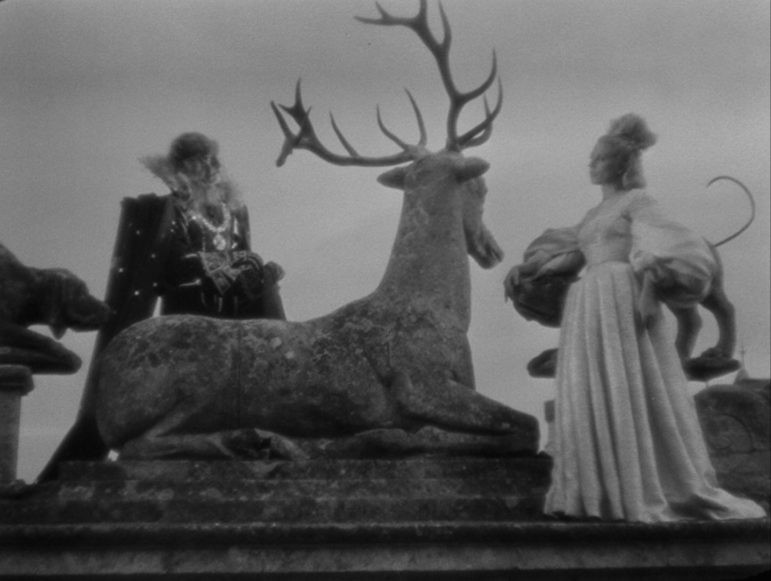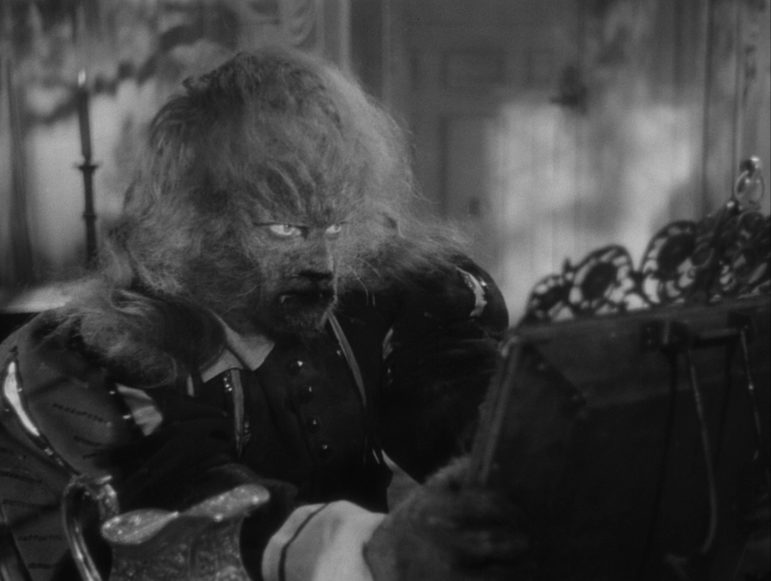
Classics of Pagan Cinema is a new occasional series in our Arts and Culture section where we explore the films that continue to resonate in the Pagan imagination year after year. Do you have a classic film with Pagan themes you would like to review for the series? Send a pitch to eric@wildhunt.org.
They walk out onto a balcony, framed by vines and roses. “Look over there, Belle,” he says. “Do you see that pavilion? It’s called Diana’s Pavilion. It’s the only place in my domain where no one may enter – not you and not I. All I possess, I possess by the powers of magic, but my true riches are in that pavilion, and one can only enter with a golden key.”
She is Belle and he is the Beast, the protagonists of a story that has been told and retold since at least 1740 when Gabrielle-Suzanne Barbot de Villeneuve published La Belle et La Bête as a novel-length fairy tale. (The tale has far older roots than this, of course – there are many fairy tales where a young woman finds herself married to a monstrous husband – but Villeneuve creates the story in its familiar form.) 16 years later, Jeanne-Marie Leprince de Beaumont published a substantially abridged version, stripping the complicated plot of the original down to its essence and solidifying the story that has been adapted many times since.
And yet neither Villeneuve nor Beaumont’s tales contain a single mention of the hunter goddess Diana. Her entrance into the story is the invention of Jean Cocteau for his 1946 film adaptation of La Belle et La Bête.

Jean Marais and Josette Day as The Beast and Belle in Cocteau’s La Belle et La Bête (1946) [Criterion Collection]
You know the story already, more than likely: an old man, a merchant who has fallen on hard times, hears that one of his ships has finally arrived and sets off to collect money to pay his debts. But all the wealth has already been seized by the time he gets there, and, without even enough cash on hand to pay for a room, he must set back home. Along the way, he is lost in a dark forest and finds himself in a strange and seemingly abandoned mansion.
As he prepares to leave, he spies a rose in the courtyard and remembers that his youngest daughter, Belle, asked him to bring her back such a flower as a present. (He has three daughters, two cruel and vain, who ask for gaudy treasures; his humble youngest, who waits on the others hand and foot, asks for just a rose.) So the old merchant plucks the flower, and in doing so seals his doom.
A huge creature, dressed in an aristocrat’s finery but with the face of some sort of bear or cat, appears from the shadows, scowling. “You could have taken anything,” this creature, the Beast, says, “except my roses.” He is prepared to eat the man but offers instead to let him send one of his daughters in his place. Having no choice, the man rushes home, and his youngest, always dutiful, accepts the bargain and goes to live with the Beast.

Jean Marais as the Beast in Cocteau’s La Belle et la Bête (1946) [Criterion Collection]
But there are wrinkles, even as Cocteau’s retelling is remarkably faithful to Beaumont’s version of the story. For one, the merchant also has a son, Ludovic, who mortgages all of his father’s furniture to a moneylender. (“We always leave the beds,” the moneylender boasts, even as he takes possession of everything else in the dying man’s house.) Ludovic has a friend, Avenant, who loves Belle, but in a controlling and forceful way that leaves her no agency. (Avenant is not quite a pure villain in the way Disney’s Gaston would be in the 1991 animated adaptation, but it is clear that he is no heroic suitor, either. The actor, Jean Marais, plays both Avenant and the Beast – and was Cocteau’s lover, as well.)
Diana appears three times in the film – first as a statue in the foreboding hallway outside of Belle’s bedroom in the Beast’s haunted mansion, then as the spirit of the pavilion of riches, and finally, as a statue within that pavilion who comes to life and brings the story to its end. The presence of the goddess and her connection to the Beast serves to underscore the distinction between the worlds of the Beast and the worlds of the burghers like Belle’s father and siblings. The town is mercantile, obsessed with money and debt and social status, and tied only loosely even to the spiritual world of Christianity. (“The church tribunal will be quite interested in the display of witchcraft we just witnessed!” cries one of the wicked sisters, more offended by the opulence of Belle’s new dresses than by any magical display.) But within the Beast’s world, the old romance of paganism reigns.
The interplay between the mundane and enchanted worlds leads to the film’s climax. Belle has returned home for a visit to her father, and even overstays her promise to return to the Beast after her sister rubs onions on their eyes to make Belle think they are despondent without her. (In the very next scene the sisters are back to their snide ways: “Mademoiselle must think she’s too grand to wait on us now,” says one of them, her hair strung up in pearls despite the family’s poverty.) Ludovic and Avenant ride off to kill the Beast and steal his treasures, Ludovic hoping to pay his debts and Avenant hoping to defeat his perceived rival for Belle’s love.

A statue of the goddess Diana comes to life to punish those who would rob her in Cocteau’s La Belle et La Bête (1946) [Criterion Collection]
When they arrive at the Beast’s mansion, they attempt to break into Diana’s Pavilion to steal its riches. Wary of going in through the front door with a stolen golden key, they climb to the roof and break in through the glass ceiling. Diana comes to life and shoots Avenant with an arrow – a shot that leaves him transformed into the new incarnation of the Beast, punished for his crime of attempting to steal the goddess’s enchanted treasures for his friend’s quotidian debts.
At the same time, Belle reunites with the Beast, who is dying of heartbreak for her: “Poor beasts who wish to prove their love can only grovel on the ground and die,” he says before he seems to pass away. But then he springs up again, the Beast no longer, but now a prince with the face of Avenant. Famously, Belle seems less than pleased by this development – “It’s almost as if you miss my ugliness,” says the prince as she studies him – but still, our lovers fly away into the night together.
What strikes me every time I watch La Belle et La Bête is how much older it seems than it really is. The film is from 1946, not only after The Wizard of Oz but after Casablanca and Spellbound. But this fairy tale story of the virtuous Belle and her tormented Beast, of the mundane world of the town and the enchanted otherworld of the Goddess, feels as though it must have always been there, since the beginning of cinema – perhaps even from somewhere before then, once upon a time.
La Belle et La Bête is available to stream on the Criterion Channel.
The Wild Hunt is not responsible for links to external content.
To join a conversation on this post:
Visit our The Wild Hunt subreddit! Point your favorite browser to https://www.reddit.com/r/The_Wild_Hunt_News/, then click “JOIN”. Make sure to click the bell, too, to be notified of new articles posted to our subreddit.